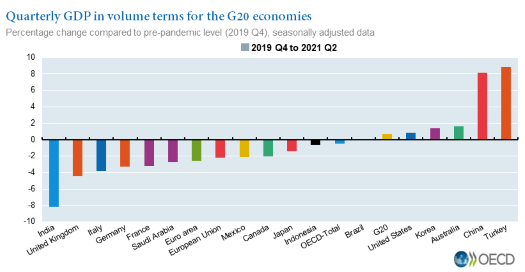but large differences exist across countries
Download the entire news release (PDF 120KB)
15 September 2021 - Gross domestic product (GDP) of the G20 area grew by 0.4% in the second quarter of 2021, down from 0.9% in the first quarter of 2021. However, this figure conceals large differences in the growth observed across countries.
Among the G20 economies, GDP growth slowed in Turkey (to 0.9%, from 2.2%), Korea (to 0.8%, from 1.7%) and Australia (to 0.7%, from 1.9%). GDP contracted sharply in India (by (minus) 10.2%, after 2.3% growth). GDP also contracted, to a lesser extent, in Canada (by (minus) 0.3%, after 1.4% growth) and Brazil (by (minus) 0.1%, after 1.2% growth).
GDP growth resumed in the United Kingdom (to 4.8%, following a contraction of (minus) 1.6%), in the European Union as a whole (to 2.1%, following a contraction of (minus) 0.1%), in Germany (to 1.6%, following a contraction of (minus) 2.0%), in Saudi Arabia (to 1.1%, following a contraction of (minus) 0.5%) and in Japan (to 0.5%, following a contraction of (minus) 1.1%). Remaining G20 economies recorded accelerating growth rates in the second quarter of 2021: Italy (2.7%, from 0.2%), the United States (1.6%, from 1.5%), Mexico (1.5%, from 1.1%), China and Indonesia (1.3% in both countries, from 0.4% and 0.3%, respectively) and France (1.1%, from 0.0%).
In the second quarter of 2021, GDP for the G20 area as a whole exceeded its pre-pandemic level (Q4-2019) by 0.7%, driven by China, which, together with Turkey, recorded the highest recovery rates (8.2% and 8.8%, respectively). However, the majority of countries are still lagging behind pre-pandemic levels, with India experiencing the largest gap (minus 8.1%), followed by the United Kingdom (minus 4.4%) and Italy (minus 3.8%).
Source: OECD Quarterly National Accounts Database







